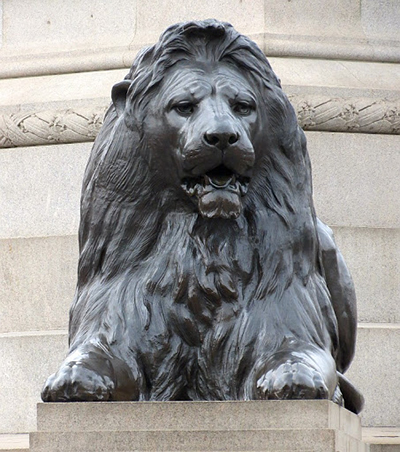Landseer was a renowned animal painter, and would take on a number of creatures during his career. Lions appealed to him for a number of reasons, some physical and some symbolic. Their strength and power was used to portray the British Empire in this series of four bronze sculptures.
They have remained on display ever since their first appearance and are key part of London's sculptural offering. Their position in the centre of Trafalgar Square, a popular tourist hotspot, has ensured that they are more familiar to the public than the artist himself. They are worthy supporting acts to the main figure who is placed above, completing Admiral Nelson's Column. Lord Nelson was considered one of the most important British figures in history and it was important that his memorial would be sufficiently grand and also located in a suitably significant spot. It would have to be London, the nation's capital, and it would be Trafalgar Square, a central location that all were aware of. Many travelled through this area on a daily basis, just as they might past Parliament, where a number of other notable sculptured figures can be found.
It was unquestionably a massive honour for Landseer to be commissioned to work on this project, and even though sculpture was not his primary artistic medium, he threw himself into the work with his normal passion and he successfully delivered additions to the memorial which were entirely fitting. A beautiful memory is that of during Landseer's funeral, a significant occasion at the time, his lions received wreaths to celebrate their creator. There was also a portrait of the artist alongside one of his lions which was one of the very first portraits of him to be displayed at the National Portrait Gallery, a famous venue which is just around the corner from Nelson’s Column. The overall piece took many years to put together, with a large amount of politics and bureaucracy involved in the project.
Landseer himself was awarded the work in 1858, some 15 years after the sculpture of Nelson had already been finished and put in place. Other supporting elements were added in 1846, but it took a long time until work for the lions would commence. We do know that Landseer was initially anxious about his relative inexperience in this medium, but friends convinced him to take it on. There was also no doubt about his technical understanding with regards the animal world, which would also be an important element in putting the lions together. Whilst not having much experience within the medium of sculpture, the artist had been learning about animals all of his life. He had been encouraged as a young student to examine dissected animals in order to truly understand their workings. This was a method used by George Stubbs, himself a British artist who produced extraordinary recreations of horses in supreme detail. Landseer also borrowed a number of sketches from his tutors on these themes in order to develop his skills as a draftsman.
This was an artist who had been sketching and painting animals for decades, including lions. With the right tutoring from more experienced sculptors, it could be a perfect combination for this project. Despite that, the press quickly set out their rejection of this idea - a painter to do a sculptor’s work, on such an important, national project? Their scepticism is perhaps understandable and some of the production decisions that followed were led by the artist’s limited abilities in this art form. For instance, bronze was chosen because he felt more comfortable with that material, rather than it necessarily being the best artistic choice. Stone, for example, would have revealed his problems in using a chisel, but clay would have been another option in which he would have felt reasonably comfortable. To give this project an even greater connection to the city in which it was planned for display, the artist was actually sent an old lion from London Zoo from which he could make a series of preparatory drawings. Amusingly, for those with a dark sense of humour, the lion passed away fairly soon after its arrival which forced Landseer’s assistant, Frederick Keyl, to prop the creature up so that studies could continue.
[Landseer was confident that his] "...experience of the animal - photographs, casts in plaster - and studies... [would] ...neither disappoint the country or the brave Nelson in my treatment of these symbols of our national defences..."
Despite his considerable prior knowledge, the artist decided to spend yet more time studying lions in a variety of locations across the UK. At this time, there were very few locations where one might view lions in this country, but enough for Landseer to continue to study this creature in as much depth as possible. He was always waiting upon a delivery from Italy regarding some reproduced lion casts that would help him in his work, but these were considerably delayed until finally arriving in the summer of 1861. There was even an announcement in parliament about the progress of the lions, which added further pressure onto the artist’s shoulders. The artist had hired the studio of Baron Carlo Marochetti and he had helped the artist to source these valuable resources from Italy. Edwin Henry was aware of his limitations and despite his normally bullish character, was willing to draw in all manner of advice and influences in order to meet the requirements of this high profile project.




